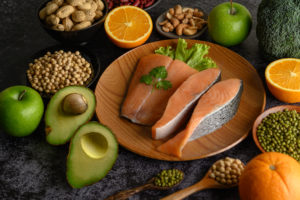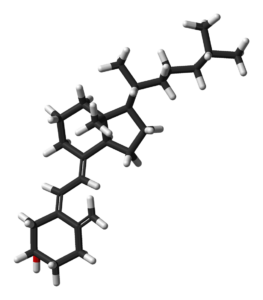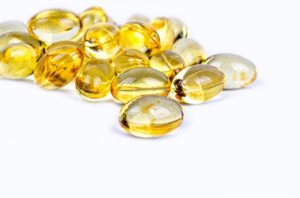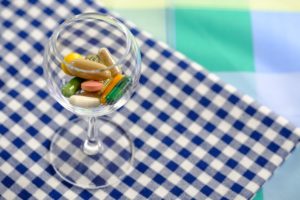
My next compound of the month is Vitamin D. The human body produces vitamin D under the influence of sunlight, which is why it is often called the vitamin of the sun.

Vitamin D, in addition to vitamins A, E and K, belongs to the group of fat-soluble vitamins. It was discovered in 1919 by Mellanbe, who for the first time showed that rickets can be caused by a deficiency in the diet of fat-soluble substances.
Vitamin D is not only one compound – is group of steroids compounds showing this same biological activity of cholecalciferol. It occurs in nature in form of Vitamin D2 (ergocalciferol) and D3 (cholecalciferol). We can found ergocalciferol in products of plant origin, while cholecalciferol in products of animal origin: fatty fish (mackerel, salmon, sardines), fish oils (fish oil), chicken eggs and liver, and in smaller amounts in meat, offal, poultry and dairy products.

Vitamin D is also synthesized in the skin from 7-dehydrocholesterol under the influence of solar radiation. Its synthesis depends on such factors as: the degree of sunlight, latitude, time of day, season, exposed body part, use of solarium, skin complexion, body weight, amount of fat tissue, thickness of cloud cover and the degree of air pollution.


Vitamin D formula
The main circulating metabolite of vitamin D is 25-hydroxyvitamin D [25(OH)D], which perfectly accounts for the amount Vitamin D in the body, derived from both diet and synthesized in the skin.
Table 1. Classification of Vitamin D Status of 25-hydroxyvitamin D concentration in serum
| 25(OH)D concentration | Classification |
| ≤30 ng/mL | Deficiency |
| 30-80 ng/mL | Recommended level |
| >100 ng/mL | Toxic level |
The content of vitamin D in various food products was prepared in the form of a table:
Table 2. Vitamin D content
| Foodstuff | Vitamin D | Foodstuff | Vitamin D |
| Fresh eel | 1200 IU/100 g | Women’s food | 1.5-8 IU/100 ml |
| Herring in oil | 808 IU/100 g | Initial milk | 40-50 IU / 100 ml |
| Cooked/baked salmon | 540 IU/100 g | Cow’s milk | 0.4-1.2 IU/100 ml |
| Cooked / baked mackerel | 152 IU/100 g | Milk-rice porridges | 160-480 IU/100 g |
| Canned fish (tuna, sardines) | 200 IU/100 g | Milk-cereal porridges with | 64-80 IU/100 ml |
| Egg yolk | 54 IU/yolk | Yoghurt | 2 IU/100 g |
| Yellow cheese | 7.6-28 IU/100 g | Cod-liver oil | 400 IU/teaspoon |

Vitamin D doses are necessary to have good health and be in good mood. Content in serum of 25(OH)D levels of > 30 ng/ml are presented below. The values are presented for healthy people who do not have problems with obesity.
| low skin synthesis * | high skin synthesis ** | |
| Autumn | 200 IU/day | 0 IU/day |
| Winter | 1500 IU/day | 1100 IU/day |
| Spring | 850 IU/day | 50 IU/day |
| Summer | 0 IU/day | 0 IU/day |
*low skin synthesis – exposure to solar radiation in the summer about 18% of the body surface area minimum 20 minutes a day.
** high skin synthesis – exposure to solar radiation in summer about 35% of the body surface area for a minimum of 90 minutes a day.
Prudent supplementation is also important. A single dose should not exceed 60,000 IU. According to the latest standards, the approved safe dose is 4,000 IU/day. The toxic dose is considered to be > 30,000 IU of vitamin D per day for more than 3 months. The risk of hypercalcaemia was observed at 25-(OH)-D in serum levels about >200 ng/ml.

Vitamin D supplementation for adults is a dose of 800-1000 IU per day depending on body weight is safe in the period from October to April if sufficient skin synthesis of vitamin D is ensured in summer.
In people over 65 due to reduced skin synthesis and proven anti-fracture and anti-fall effect, vitamin D supplementation at a dose of 800-1000 IU/day throughout the year is recommended.
For children from 1 to 18 year old the supply of vitamin D with food and/or pharmaceutical preparations should be 400 IU/day in the period from October to March, as well as in the summer months if sufficient skin synthesis of vitamin D is not ensured.
Higher doses must be given to overweight or obese children to increasing the vitamin D level to 800-1000 IU/day.

Vitamin D deficiency diseases are very dangerous. I present a list of diseases related to vitamin D deficiency
| Bone diseases | Extracostal diseases : |
children:
|
|
adults:
|
So the amount of vitamin D is important at all ages. You should not only supplement yourself at the right time but also consume the right products. Do not forget to practice sports or even everyday walks beneficial and needed for the synthesis of vitamin D!

Sources:
- P. Płudowski, E. Kryśkiewicz, E. Karczmarewicz. Vitamin D provision and supplementation standards,
- T. D. Thacher, B. L. Clarke Vitamin D Insufficiency,
- A. Dittfeld, K. Gwizdek, A. Koszowska, K. Fizia Multidirectional effect of vitamin D,
- P. Płudowski, E. Kryśkiewicz, E. Karczmarewicz Vitamin D provision and supplementation standards,
- L. Napiórkowska, E. Franek Rola oznaczania witaminy D w praktyce klinicznej,
- Kwiecień 2010, Vol. 14 Nr 2 Pediatria po Dyplomie | Polskie zalecenia dotyczące profilaktyki
niedoborów witaminy D – 2009

Absolwent chemii Uniwersytetu w Białymstoku, nauczyciel z wyboru. Uczę chemii w ZSO nr 2 w Białymstoku ( SP53, II LO oraz IB World School No. 6159 – wszystko w jednym miejscu 😉 ) Szukam ciekawych sposobów na zarażanie młodzieży pasją do chemii. Nauczanie dwujęzyczne oraz w programie Matury Międzynarodowej to moje codzienne wyzwania. Na co dzień ojciec najbardziej wymagającej młodzieży, czyli małych córek 😉